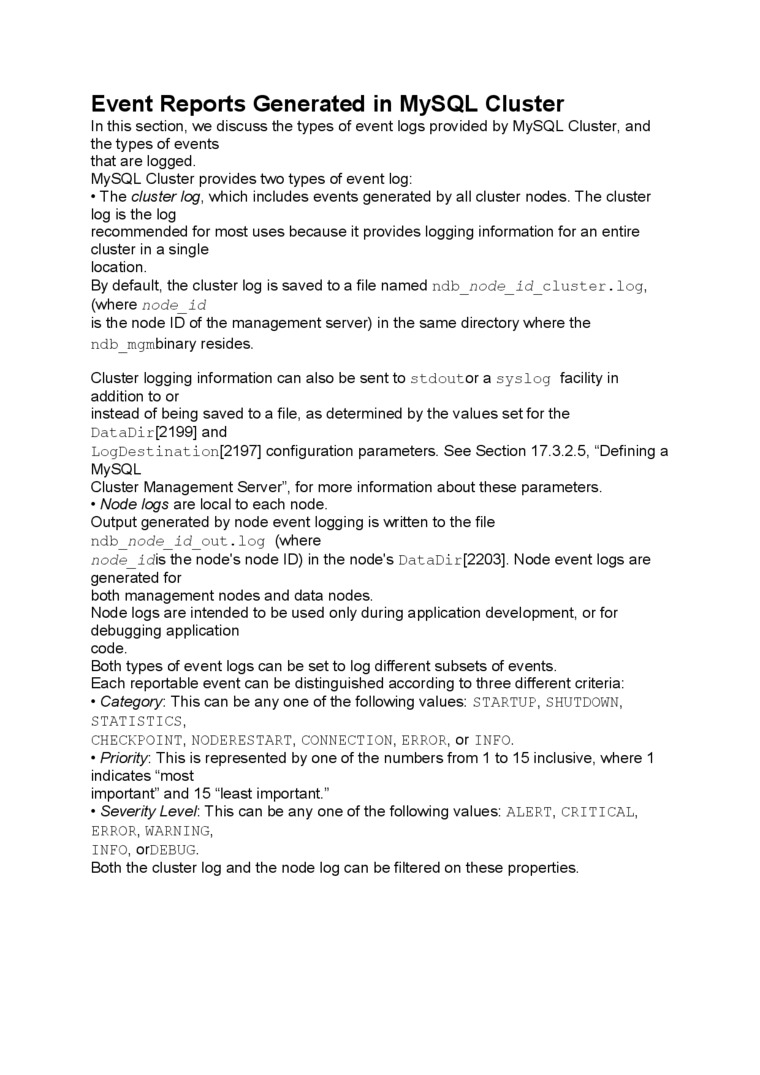89330

Event Reports Generated in MySQL Cluster
In this section, we discuss the types of event logs provided by MySQL Cluster, and the types of events that are logged.
MySQL Cluster provides two types of event log:
• The cluster log, which includes events generated by all cluster nodes. The cluster log is the log
recommended for most uses because it provides logging information for an entire
cluster in a single
location.
By default, the cluster log is saved to a file named ndb_node_id_cluster. log, (where node_id
is the node ID of the management server) in the same directory where the ndb mgmbinary resides.
Cluster logging information can also be sent to stdoutor a syslog facility in addition to or
instead of being saved to a file, as determined by the values set for the DataDir[2199] and
LogDestination[2197] configuration parameters. See Section 17.3.2.5, “Defining a MySQL
Cluster Management Server", for morę information about these parameters.
• Node logs are local to each node.
Output generated by node event logging is written to the file
ndb_node_id_out. log (where
node_idis the node's node ID) in the node‘s DataDir[2203], Node event logs are generated for
both management nodes and data nodes.
Node logs are intended to be used only during application development, or for
debugging application
codę.
Both types of event logs can be set to log different subsets of events.
Each reportable event can be distinguished according to three different criteria:
• Category: This can be any one of the following values: STARTUP, SHUTDOWN, STATISTICS,
CHECKPOINT, NODERESTART, CONNECTION, ERROR, or INFO.
• Priority. This is represented by one of the numbers from 1 to 15 inclusive, where 1 indicates “most
important” and 15 “least important."
• Severity Level: This can be any one of the following values: ALERT, CRITICAL, ERROR, WARN ING,
INFO, orDEBUG.
Both the cluster log and the node log can be filtered on these properties.
Wyszukiwarka
Podobne podstrony:
Initial Configuration of MySQL Cluster In this section, we discuss manuał configuration of an instal
Replication with Global Transaction Identifiers In this section, we discuss transaction-based replic
141 5.6 Discussion In this study, we investigated the effect of winter metabolism on survival of fre
00139 >858430acb91880687589de10557be5 140Simpson & KeatsEconomic-Statistical Approach Using Tra
00219 a6d333666646e915e39fbc117115f5 221 Applications of the EWMA The Control Algorithm In this al
1 In this section we briefly discuss why it benefits your PhD program to work according to a Schedul
On the complex o-ineąualityPiotr Nayar. Tomasz Tkocz Abstract In this notę we prove the complex coun
Simple description Bcforc we discuss the steps of thc procedurę, some generał rcmarks arc in order.
3 The Phanariots” in Romanian Textbooks 43 3a. The image of Phanariots was created by two eleme
23844 pg048 Sleeves This section concentiates on three types of steeve: seevcs set mto the normal bo
MySQL Cluster Data Node Configuration Parameters The summary table in this section provides informat
Bndging By default, one bridge (brO) is defined and active. In this section you can define additiona
Jak zrobić księżyc ?sy Crescent Moon Tutorial PS by Rach Resources ANG In this example, we // make i
Synergy as a lalue Generator in Tourism 11 costs. And the fact that it pays taxes as if it achieves
Synergy as a lalue Generator in Tourism 13 4. processes and innovations: - ąuality
Logistyka - nauka of this new approach is the creation of a cohesive transport system in the Europea
więcej podobnych podstron